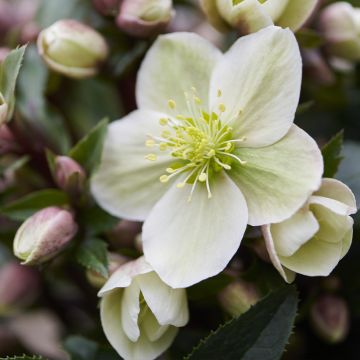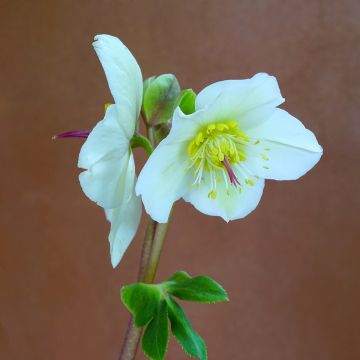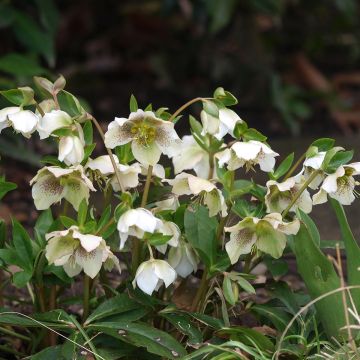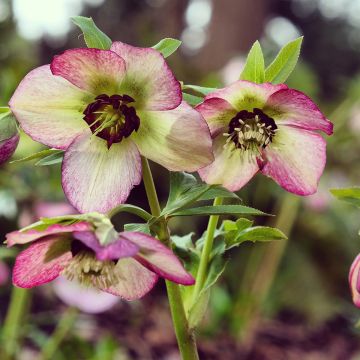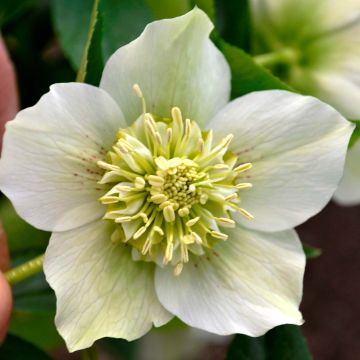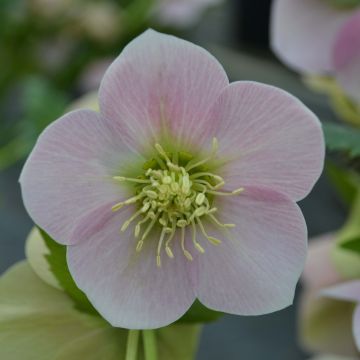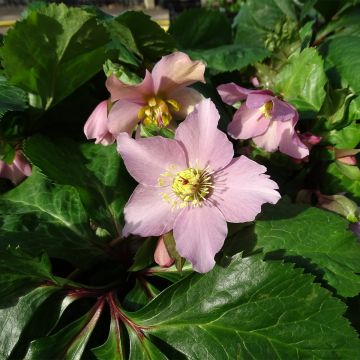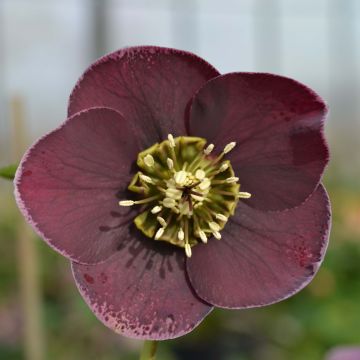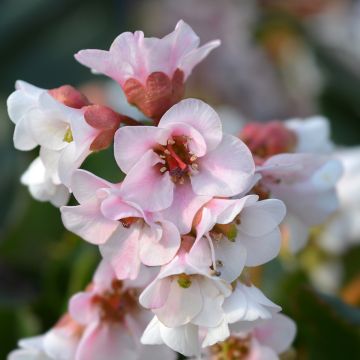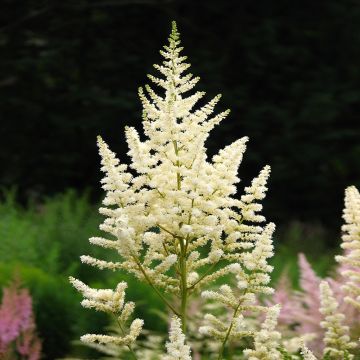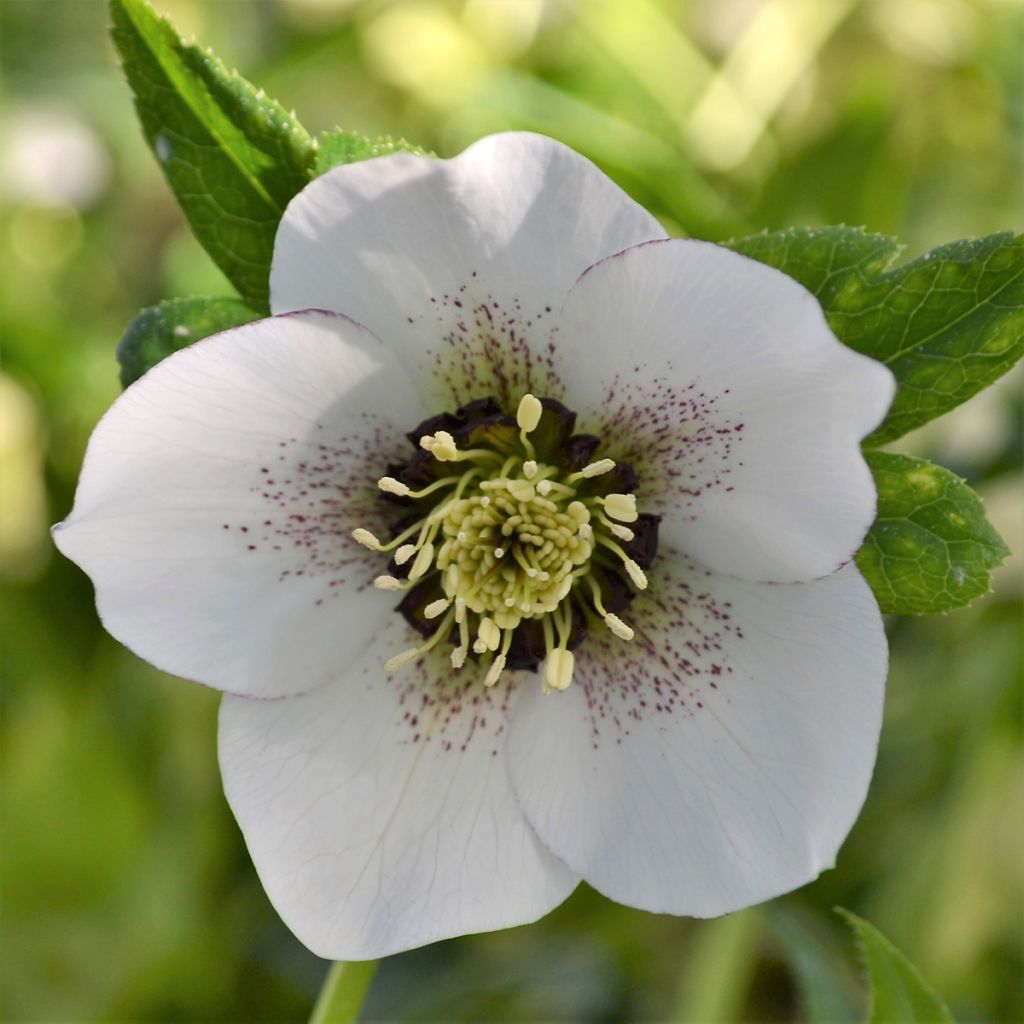

Hellébore ViV Giorgia - Helleborus orientalis
Helleborus hybridus ViV Giorgia
Helleborus x hybridus ViV Giorgia
Lenten Rose, Oriental Hellebore
Why not try an alternative variety in stock?
View all →This plant carries a 12 months recovery warranty
More information
We guarantee the quality of our plants for a full growing cycle, and will replace at our expense any plant that fails to recover under normal climatic and planting conditions.
From €5.90 for pickup delivery and €6.90 for home delivery
Express home delivery from €8.90.
Does this plant fit my garden?
Set up your Plantfit profile →
Description
Giorgia is a variety of Oriental Hellebore with winter flowers that exudes an irresistible romantic charm. Blooming for several weeks from January, this Lenten Rose produces single flowers in pure white with irregularly scattered small red spots on the petals. The greenish heart supports the pale yellow stamens, which contribute delicately to this ensemble of colours. This evergreen perennial forms a dense and compact clump about forty centimetres in all directions. It can be grown in a large pot to decorate a balcony or in the ground in the garden where it requires a shady exposure and a neutral to alkaline soil, but will tolerate some acidity. It is hardy enough to be planted in virtually all regions.
Hellebore Giorgia is a member of the Ranunculaceae family, which includes about sixty genera and around 2500 species. Many of them are poisonous, they contain toxic substances if ingested - a natural protection to prevent them from being grazed by herbivores. Despite this, they are valuable plants in the garden, as many genera are highly ornamental thanks to their remarkable flowering, such as Anemones, Buttercups, Trollius, Aconites, and many others, not to mention Clematis. The species Helleborus orientalis is native to Greece, Turkey, and the centre and east of the Caucasus. It is a perennial plant that hybridizes very easily with other species, resulting in hybrids with very varied colours and shapes from random sowings, distinguished by their shape and colour characteristics. Hybrid Hellebores are hardy plants that can tolerate temperatures down to -15°C (5°F), naturally growing in forests, thickets, and clearings up to 2,000 m (7ft) altitude.
Giorgia is a variety distributed by a Belgian company specializing in the selection and in vitro multiplication of Hellebores. This method of propagation ensures the perfect transmission of genes and the stability of the varieties, which are all perfectly identified by their name. Giorgia is part of a large collection of hybrids selected for their compactness and floribundance. This variety forms a clump about 40 cm (16in) tall and wide, particularly well suited for container cultivation. Place it on your balcony or terrace and this beautiful potted plant will offer you a stunning winter spectacle. The leaves are evergreen in winter. In reality, they only live for 8 months and are regularly replaced by new leaves. Their sculptural shape is particularly decorative throughout the year.
Giorgia blooms at the beginning of the year and produces flowers for several weeks, illuminating the garden with its light flowers, which are very visible during the dark days of the year. Its well-joined petals, slightly overlapping, form a simple, fairly regular corolla of bright white. The petals are adorned with small red spots in irregular proportions, creating a pretty asymmetry. Many pale yellow stamens emerge from the green centre in a charming pastel harmony. Carried by sturdy stems, these corollas open vertically, as in most Hellebore varieties, or even slightly inclined downwards, allowing water to slide off like an umbrella, preventing accumulation in the centre that could cause rot. Hellebores do not like to be moved once established, and young shoots sometimes take time to flower. Therefore, be sure to choose their location carefully when planting.
This perennial adapts to neutral to moderately alkaline (chalky) soils, and even slightly acidic soils, preferably rich and retaining some moisture, although a planted specimen can withstand dry conditions. However, make sure the soil is well-drained, as Hellebores do not tolerate excess water in winter. It will thrive under a leafy tree, which will allow winter sun but protect it from the intense summer sun, which is too bright for it. Its compact, wider than tall shape makes it an excellent potted plant to decorate a balcony or terrace.
Lenten Roses are among the few plants that flower in winter with a real decorative value. You can plant Giorgia alongside other varieties of Hellebores that will offer you varied blooms in terms of colours and forms from autumn to early spring. To create a partial shade flowerbed, mix different types of plants. Consider decorative bark shrubs like the fabulous Acer conspicuum Red Flamingo, which will dazzle you with its tricoloured foliage - green, cream-white, and pink - during the growing season. Then in winter, you can admire the "snake skin" bark of its main stem and vivid red of its branches. Of course, colourful foliage is also a source of inspiration with conifers and evergreens, the Aucuba genus is particularly valuable with its variegated cultivars in bright yellow, which brighten up shaded areas where it thrives. Finally, decorative fruiting shrubs, like the charming Symphoricarpos, will also provide a quality backdrop for your Hellebores.
Report an error about the product description
Flowering
Foliage
Plant habit
Safety measures
Botanical data
Helleborus
x hybridus
ViV Giorgia
Ranunculaceae
Lenten Rose, Oriental Hellebore
Cultivar or hybrid
ingestion
Cette plante est toxique si elle est ingérée volontairement ou involontairement.
Ne la plantez pas là où de jeunes enfants peuvent évoluer, et lavez-vous les mains après l'avoir manipulée.
Pensez à conserver l'étiquette de la plante, à la photographier ou à noter son nom, afin de faciliter le travail des professionnels de santé.
Davantage d'informations sur https://plantes-risque.info
Other Oriental Hellebore
Planting and care
Oriental Hellebore Giorgia grows in any neutral to moderately chalky soil, even slightly acidic, rich, light or clayey, in partial or light shade, sheltered from cold winds. Avoid direct sunlight during the hottest hours by choosing a shaded (partially shaded in the north) exposure. This perennial can be planted from early autumn to spring. It thrives in deeply worked soil mixed with organic matter. To feed, use bone meal or another organic fertilizer. Water the plants well after planting and then add a layer of mulch 2 to 5 cm (1 to 2in) thick. Make sure to plant them at a distance of 30 to 40 cm (12 to 16in) apart to promote their development. Hellebores do not tolerate stagnant water as it may cause them to rot.
The roots should not dry out completely in summer. Hellebores can be affected by a fungal disease transmitted by aphids, known as black spot disease. Remove any stained leaves when the flower buds appear. Remove faded flowers after seeding. They can also suffer from grey rot or die from collar rot due to poor growing conditions, in overly wet situations.
You can also plant this compact plant in a pot on a balcony or terrace, but make sure to choose a sufficiently large pot for its root system to develop properly. This hardy Hellebore can withstand temperatures down to -15°C (5°F) or even lower.
Planting period
Intended location
Care
This item has not been reviewed yet - be the first to leave a review about it.
Shade-loving perennials
Haven't found what you were looking for?
Hardiness is the lowest winter temperature a plant can endure without suffering serious damage or even dying. However, hardiness is affected by location (a sheltered area, such as a patio), protection (winter cover) and soil type (hardiness is improved by well-drained soil).

Photo Sharing Terms & Conditions
In order to encourage gardeners to interact and share their experiences, Promesse de fleurs offers various media enabling content to be uploaded onto its Site - in particular via the ‘Photo sharing’ module.
The User agrees to refrain from:
- Posting any content that is illegal, prejudicial, insulting, racist, inciteful to hatred, revisionist, contrary to public decency, that infringes on privacy or on the privacy rights of third parties, in particular the publicity rights of persons and goods, intellectual property rights, or the right to privacy.
- Submitting content on behalf of a third party;
- Impersonate the identity of a third party and/or publish any personal information about a third party;
In general, the User undertakes to refrain from any unethical behaviour.
All Content (in particular text, comments, files, images, photos, videos, creative works, etc.), which may be subject to property or intellectual property rights, image or other private rights, shall remain the property of the User, subject to the limited rights granted by the terms of the licence granted by Promesse de fleurs as stated below. Users are at liberty to publish or not to publish such Content on the Site, notably via the ‘Photo Sharing’ facility, and accept that this Content shall be made public and freely accessible, notably on the Internet.
Users further acknowledge, undertake to have ,and guarantee that they hold all necessary rights and permissions to publish such material on the Site, in particular with regard to the legislation in force pertaining to any privacy, property, intellectual property, image, or contractual rights, or rights of any other nature. By publishing such Content on the Site, Users acknowledge accepting full liability as publishers of the Content within the meaning of the law, and grant Promesse de fleurs, free of charge, an inclusive, worldwide licence for the said Content for the entire duration of its publication, including all reproduction, representation, up/downloading, displaying, performing, transmission, and storage rights.
Users also grant permission for their name to be linked to the Content and accept that this link may not always be made available.
By engaging in posting material, Users consent to their Content becoming automatically accessible on the Internet, in particular on other sites and/or blogs and/or web pages of the Promesse de fleurs site, including in particular social pages and the Promesse de fleurs catalogue.
Users may secure the removal of entrusted content free of charge by issuing a simple request via our contact form.
The flowering period indicated on our website applies to countries and regions located in USDA zone 8 (France, the United Kingdom, Ireland, the Netherlands, etc.)
It will vary according to where you live:
- In zones 9 to 10 (Italy, Spain, Greece, etc.), flowering will occur about 2 to 4 weeks earlier.
- In zones 6 to 7 (Germany, Poland, Slovenia, and lower mountainous regions), flowering will be delayed by 2 to 3 weeks.
- In zone 5 (Central Europe, Scandinavia), blooming will be delayed by 3 to 5 weeks.
In temperate climates, pruning of spring-flowering shrubs (forsythia, spireas, etc.) should be done just after flowering.
Pruning of summer-flowering shrubs (Indian Lilac, Perovskia, etc.) can be done in winter or spring.
In cold regions as well as with frost-sensitive plants, avoid pruning too early when severe frosts may still occur.
The planting period indicated on our website applies to countries and regions located in USDA zone 8 (France, United Kingdom, Ireland, Netherlands).
It will vary according to where you live:
- In Mediterranean zones (Marseille, Madrid, Milan, etc.), autumn and winter are the best planting periods.
- In continental zones (Strasbourg, Munich, Vienna, etc.), delay planting by 2 to 3 weeks in spring and bring it forward by 2 to 4 weeks in autumn.
- In mountainous regions (the Alps, Pyrenees, Carpathians, etc.), it is best to plant in late spring (May-June) or late summer (August-September).
The harvesting period indicated on our website applies to countries and regions in USDA zone 8 (France, England, Ireland, the Netherlands).
In colder areas (Scandinavia, Poland, Austria...) fruit and vegetable harvests are likely to be delayed by 3-4 weeks.
In warmer areas (Italy, Spain, Greece, etc.), harvesting will probably take place earlier, depending on weather conditions.
The sowing periods indicated on our website apply to countries and regions within USDA Zone 8 (France, UK, Ireland, Netherlands).
In colder areas (Scandinavia, Poland, Austria...), delay any outdoor sowing by 3-4 weeks, or sow under glass.
In warmer climes (Italy, Spain, Greece, etc.), bring outdoor sowing forward by a few weeks.

































